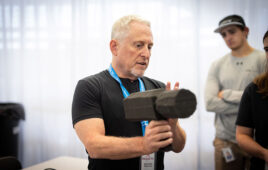By

UC Riverside astrophysicist Stephen Kane (Stan Lim/UCR)
The James Webb Space Telescope, the most complex and expensive space laboratory ever created, is less than two weeks away from its ultimate destination a million miles from Earth. Once it arrives, it will send information about parts of space and time never seen before. It will also send previously unattainable information about parts of our own solar system.
UC Riverside astrophysicist Stephen Kane’s group will be using the telescope to look for planets like Venus in other parts of the galaxy. In addition to work with the Webb mission, Kane is also joining NASA on missions to Venus expected to launch after 2028.
Here, he breaks down some unique aspects of the Webb, explains how the separate Venus projects intersect, and how both might benefit Earth.
Q: How will you be using Webb’s technology to help you understand more about Venus? Also, why are you studying Venus?
A: Venus could be described as a runaway greenhouse hellscape. It has surface temperatures of up to 800° F, no water and floats in a nest of sulfuric acid clouds. In my work, I’m trying to answer two questions: 1) how did Venus get to be the way it is? and 2) how commonly does this hellish state occur elsewhere?
Our separate mission to Venus is about answering the former question. That’s about studying Venus itself. Our work with the Webb is about the latter — are there other Venuses? We’ll be using Webb to measure the atmospheres of exoplanets — planets around stars other than our sun — and trying to determine whether they’re more like Earth or Venus. Specifically, Webb will help us look for carbon dioxide and other gases that could indicate runaway greenhouse states.
We are going to do these measurements on planets where we already know how long it takes them to orbit their stars, how close they are to their stars, their size and their mass. But we don’t know much about their atmospheres, or whether they’re in Venus-like states. Webb can tell us this. And it will help us see whether the fate of Venus is a common fate or not.
Q: Greenhouse gases are causing devastating changes to the climate here on Earth. Can Venus science help solve this planet’s problems?
A: Whatever happened to Venus was through non-human processes, but the effect is very similar. Venus is a preview into Earth’s future. Understanding how runaway greenhouse gases work can tell us how to prevent that future.
We know that climate change is real, that temperatures are rising. But there’s a lot of variability in predictions 50 or 100 years out because there are limits to how much we know about how planetary processes influence each other.
Volcanic outgassing, ocean currents, air currents — there are so many pieces in a complex puzzle, and we’re trying to determine our fate based only on data from Earth. We need another source of data where things have already gone wrong, and that’s Venus.
Read the full Q&A here.
To learn more about UC Riverside, visit ucr.edu.





Tell Us What You Think!